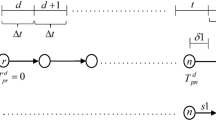Abstract
The passenger flow assignment problem for the urban transit network is relatively complicated due to the complexity of the network structure and many factors influencing the passengers’ route and line choices. In the past three decades, many models have been proposed to solve the passenger flow assignment problem. However, the common-line problem remains challenging in transit flow assignment. In this paper, the characteristics of the urban transit network is analysed and a new technique of augmented network is proposed to represent the urban transit system. The purpose is to eliminate the complex common-line problem when modeling transit passenger flow assignment. Through this augmentation technique, the urban transit system can be represented by an augmented network-it then behaves like a simple network and can be used as a generalized network for traffic assignment or network analysis. This paper presents a user equilibrium model for the urban transit assignment problem based on such a technique. A numerical example is also provided to illustrate the approach.
Similar content being viewed by others
References
Dafermos S C. Relaxation algorithm for the general asymmetric traffic equilibrium problem. Transportation Sci, 1982, 16: 231–240
Smith M J. An algorithm for solving asymmetric equilibrium problem with a continuous cost-flow function. Transport Res, 1983, 18B: 432–448
Sheffi Y. Urban transportation networks: Equilibrium analysis with mathematical programming methods. New Jersey: Prentice-Hall, Englewood Cliffs, 1985
Huang H J. A study on Logit assignment which excludes all cyclic flows. Transportation Res, 1998, 32B: 401–412
Yang H, Huang H J. The multi-class, multi-criteria traffic network equilibrium and system optimum problem. Transport Res, 2004, 38B: 1–15
Dial R B. Transit pathfinder algorithms. Highway Research Record, 1967, 205: 67–85
Fearnside K, Draper D P. Public transport assignment—A new approach. Traffic Eng Control, 1971, 298–299
Le Clercq F. A public transport assignment model. Traffic Eng Control, 1972, 91–96
De Cea J, Fernández E. Transit assignment for congested public transport systems: An equilibrium model. Transport Sci, 1993, 27(2): 133–147
Wu J H, Florian M, Marcotte P. Transit equilibrium assignment: A model and solution algorithms. Transport Sci, 1994, 28(3): 193–203
Lam W H K, Gao Z Y, Chan K S, et al. A stochastic user equilibrium assignment model for congested transit networks. Transport Res, 1999, 33B: 351–368
Cominetti R, Correa J. Common-lines and passenger assignment in congested transit networks. Transport Sci, 2001, 35(3): 250–267
Cepeda M, Cominetti R, Florian M. A frequency-based assignment model for congested transit networks with strict capacity constraints: Characterization and computation of equilibria. Transport Res, 2006, 40B: 437–459
Chriqui C, Robillard P. Common bus lines. Transport Sci, 1975, 9: 115–121
Spiess H, Florian M. Optimal strategies: A new assignment model for transit network. Transport Res, 1989, 23B: 83–102
Nguyen S, Pallottino S. Hyperpaths and shortest hyperpaths, combinatiorial optimization. In: Lecture Note in Mathematics. Berlin: Springer-Verlag, 1989. 258–271
Kurauchi F, Bell M G H, Schmöcker J D. Capacity constrained transit assignment with common lines. J Math Model Algorithm, 2003, 2(4): 309–327
Si B F, Long J C, Gao Z Y. Optimization model and algorithm for mixed traffic of urban road network with flow interference. Sci China Ser E-Tech Sci, 2008, 51(12): 2223–2232
Author information
Authors and Affiliations
Corresponding author
Additional information
Supported by the National Natural Science Foundation of China (Grant No. 70631001), the National Basic Research Program of China (“973” Project) (Grant No. 2006CB705500) and the Natural Science and Engineering Research Council (NSERC), Canada (Grant No. 342485-07)
Rights and permissions
About this article
Cite this article
Si, B., Zhong, M., Sun, H. et al. Equilibrium model and algorithm of urban transit assignment based on augmented network. Sci. China Ser. E-Technol. Sci. 52, 3158–3167 (2009). https://doi.org/10.1007/s11431-009-0260-8
Received:
Accepted:
Published:
Issue Date:
DOI: https://doi.org/10.1007/s11431-009-0260-8




